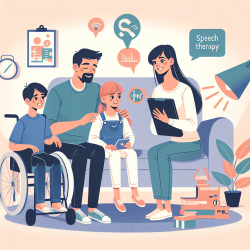In the ever-evolving field of speech-language pathology, staying abreast of the latest research is crucial for optimizing therapeutic outcomes. A recent study titled "Novel Prefrontal Synthesis Intervention Improves Language in Children with Autism" offers groundbreaking insights into enhancing language skills in children with Autism Spectrum Disorder (ASD). This blog delves into the study's findings and explores how practitioners can implement these strategies to foster better language development in their young clients.
Understanding Prefrontal Synthesis (PFS)
Prefrontal Synthesis (PFS) is defined as the ability to juxtapose mental visuospatial objects at will. This cognitive function is essential for understanding complex language structures, such as spatial prepositions and semantically-reversible sentences. The study hypothesizes that paralysis of PFS contributes to the language comprehension difficulties observed in 30-40% of individuals with ASD.
The MITA Intervention
The study employed a tablet-based intervention called Mental Imagery Therapy for Autism (MITA), which includes both verbal and nonverbal exercises aimed at developing PFS. The exercises were organized into an application that provided dynamic and engaging activities for children aged 2 to 12 years.
- Participants: 6454 children with ASD
- Duration: Three-year-long clinical trial
- Outcome Measures: Receptive and expressive language scores
Key Findings
The study revealed significant improvements in language skills among children who engaged with the MITA app. The test group showed a 2.2-fold improvement in receptive language scores and a 1.4-fold improvement in expressive language scores compared to the control group. These results were statistically significant and underscore the efficacy of PFS-targeting interventions.
Implementing PFS Strategies in Practice
For practitioners, integrating PFS-targeting exercises into therapy sessions can be a game-changer. Here are some practical steps:
- Incorporate Dynamic Exercises: Use tablet-based apps like MITA to provide engaging and adaptive exercises that target PFS.
- Start with Nonverbal Activities: Begin with nonverbal exercises to build foundational skills before introducing complex verbal tasks.
- Focus on Mental Integration: Design activities that require children to mentally combine objects, enhancing their ability to understand spatial and recursive language.
Encouraging Further Research
While the study provides compelling evidence, further research is warranted to explore the long-term effects of PFS-targeting interventions. Practitioners are encouraged to stay informed and consider participating in future studies to contribute to this growing body of knowledge.
To read the original research paper, please follow this link: Novel Prefrontal Synthesis Intervention Improves Language in Children with Autism.










